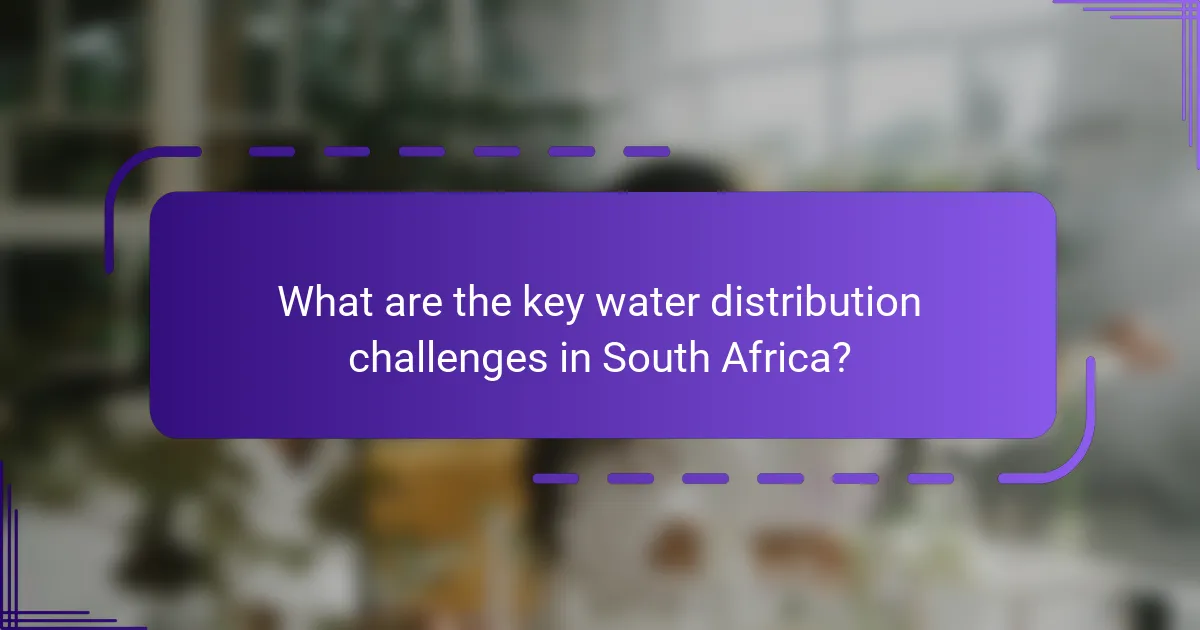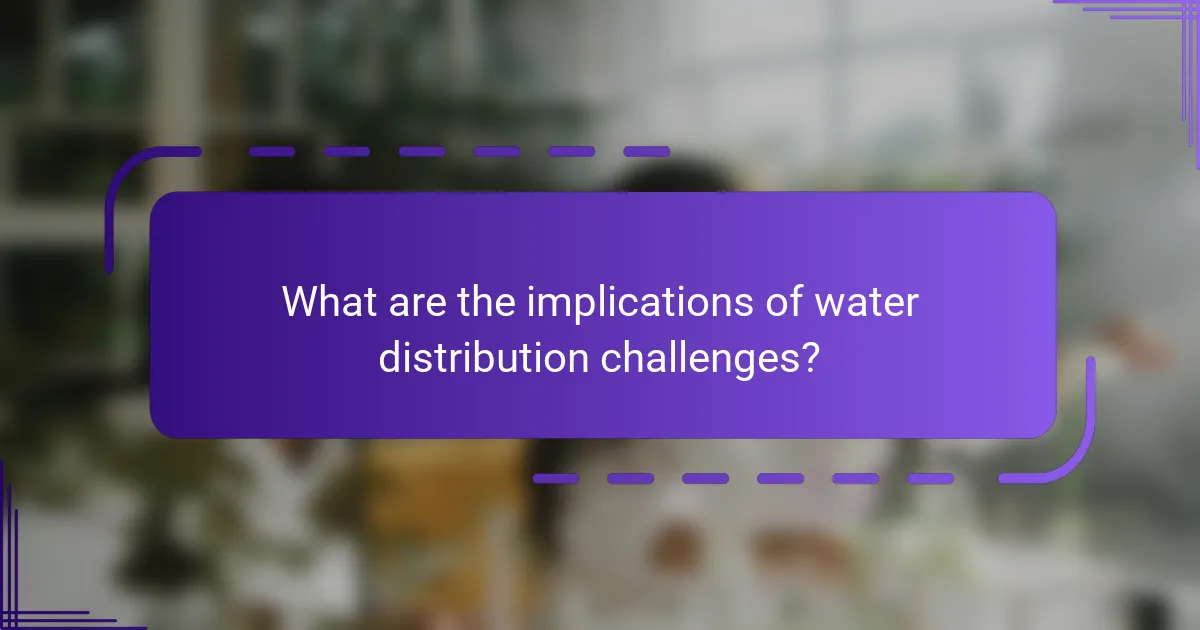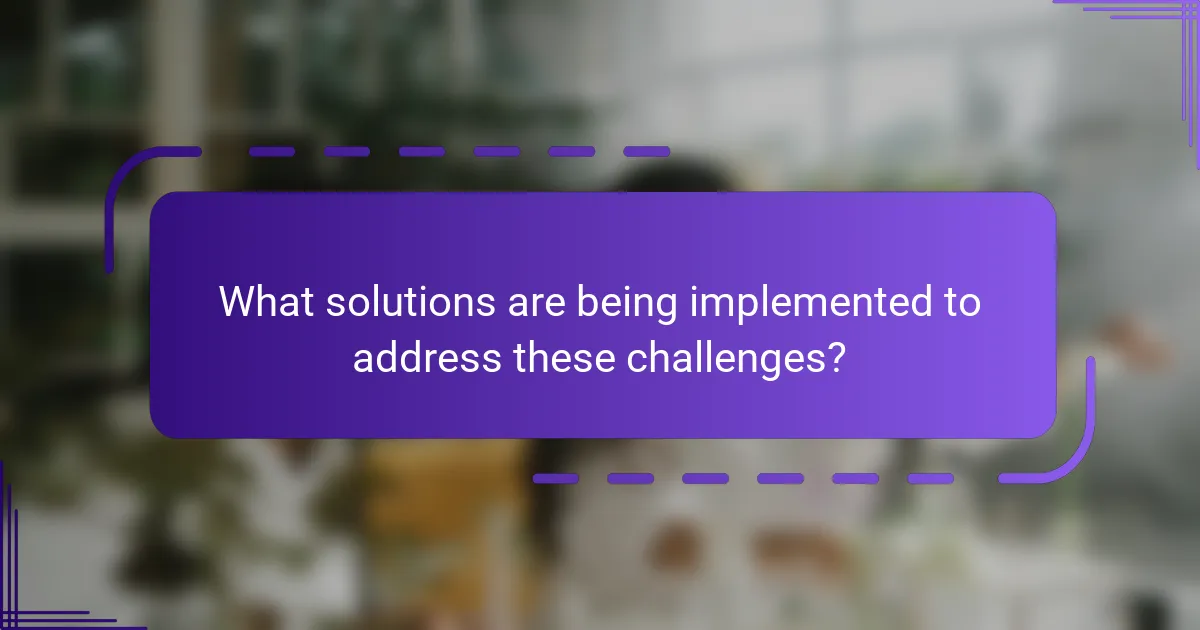Water distribution challenges in South Africa encompass aging infrastructure, unequal access, and water scarcity. The aging infrastructure results in significant water loss, with up to 37% of supply wasted due to leaks. Many rural areas experience unequal access, leaving approximately 14% of South Africans without safe drinking water. Water scarcity is intensified by climate change and rising demand, leading to severe droughts that impact availability. Solutions being implemented include infrastructure upgrades, the use of smart meters, community engagement programs, rainwater harvesting systems, and the exploration of desalination plants to enhance water accessibility and efficiency.

What are the key water distribution challenges in South Africa?
The key water distribution challenges in South Africa include aging infrastructure, unequal access, and water scarcity. Aging infrastructure leads to significant water losses through leaks and inefficiencies. According to the Department of Water and Sanitation, up to 37% of water supply is lost due to leaks. Unequal access results in many rural areas lacking reliable water sources. Approximately 14% of South Africans still do not have access to safe drinking water. Water scarcity is exacerbated by climate change and increasing demand. The country faces severe droughts, affecting water availability. These challenges highlight the urgent need for investment in infrastructure and improved management practices.
How does infrastructure impact water distribution in South Africa?
Infrastructure significantly impacts water distribution in South Africa by determining the efficiency and reliability of water delivery systems. Well-developed infrastructure facilitates the transportation of water from sources to consumers. It includes pipelines, treatment facilities, and storage systems. Conversely, inadequate infrastructure leads to water losses and service interruptions. According to the Department of Water and Sanitation, about 37% of water is lost due to leaks and inefficiencies in the system. Additionally, areas with poor infrastructure often experience unequal access to clean water. This disparity affects rural communities more than urban areas. Therefore, improving infrastructure is crucial for enhancing water distribution and ensuring equitable access across the country.
What are the current state and condition of water infrastructure?
The current state of water infrastructure in South Africa is critically challenged. Aging pipelines and treatment facilities are prevalent. Many systems are over 50 years old and require urgent upgrades. Approximately 30% of water is lost due to leaks and inefficiencies. Access to clean water remains inconsistent across urban and rural areas. The government has allocated funds for improvements but faces budget constraints. Recent studies indicate that nearly 14 million people lack reliable access to water. Ongoing maintenance is insufficient to address these challenges. The situation demands immediate attention to ensure sustainable water delivery.
How does aging infrastructure affect water delivery?
Aging infrastructure significantly impairs water delivery efficiency. Deteriorating pipes often lead to leaks and water loss. According to the World Bank, approximately 30% of water is lost in South Africa due to infrastructure issues. Reduced water pressure can occur, making it difficult for communities to receive adequate supply. Maintenance costs increase as older systems require more frequent repairs. Additionally, aging systems may not meet modern safety and quality standards. This situation exacerbates water accessibility challenges in affected areas. The overall reliability of water delivery is compromised, impacting public health and economic activities.
What factors influence accessibility to water in South Africa?
Accessibility to water in South Africa is influenced by several key factors. These include infrastructure quality, population density, and climate variability. Poor infrastructure limits the distribution and availability of water. In densely populated areas, demand often exceeds supply, leading to shortages. Climate variability, including droughts, affects water availability across regions. Socioeconomic factors also play a significant role, as lower-income communities may lack access to reliable water sources. Government policies and governance impact water management and distribution efficiency. Lastly, the presence of pollution in water sources can further limit accessibility.
How do geographical disparities affect water access?
Geographical disparities significantly affect water access by creating unequal distribution and availability of water resources. Regions with abundant water sources often experience better infrastructure and accessibility. In contrast, arid areas may struggle with limited water supply and inadequate delivery systems. For example, urban areas in South Africa typically have more developed water infrastructure than rural regions. According to the South African Human Sciences Research Council, rural communities often face challenges such as unreliable water sources and long distances to access water points. These disparities can lead to health issues and economic disadvantages for affected populations.
What role do socio-economic factors play in water accessibility?
Socio-economic factors significantly influence water accessibility. Wealthier communities often have better infrastructure for water supply. They can invest in advanced water treatment and distribution systems. In contrast, low-income areas may lack these resources. This leads to unreliable water sources and limited access. Education also plays a role; communities with higher education levels understand water management better. Additionally, socio-economic status affects political influence. Wealthier populations can advocate for better policies and infrastructure improvements. According to the World Bank, water scarcity disproportionately affects poorer regions. This highlights the critical link between socio-economic conditions and water accessibility.
Why is efficiency important in water distribution systems?
Efficiency is crucial in water distribution systems to ensure optimal resource utilization. Efficient systems reduce water loss, which can exceed 30% in some areas. This loss often occurs due to leaks and outdated infrastructure. By minimizing waste, communities can meet demand without over-extracting from sources. Efficient systems also lower operational costs, benefiting both providers and consumers. Additionally, they enhance service reliability, ensuring consistent access to water. Improved efficiency contributes to sustainability, supporting long-term water availability. In South Africa, addressing efficiency can mitigate challenges posed by limited water resources and infrastructure deficits.
What are the metrics used to measure efficiency in water distribution?
Key metrics used to measure efficiency in water distribution include water loss percentage, operational efficiency, and service coverage. Water loss percentage quantifies the volume of water lost due to leaks and inefficiencies. Operational efficiency assesses the ratio of water produced to water delivered. Service coverage measures the percentage of the population with access to reliable water sources. According to the World Bank, reducing water loss can lead to significant cost savings and improved service delivery. These metrics are crucial for optimizing water distribution systems, especially in regions facing infrastructure challenges.
How can improvements in efficiency benefit communities?
Improvements in efficiency can significantly benefit communities by optimizing resource use and reducing waste. Enhanced efficiency in water distribution systems can lead to lower operational costs. For instance, reducing leaks in pipelines can save communities up to 30% of their water supply, as demonstrated by initiatives in Cape Town. Efficient systems also ensure more reliable access to clean water. This reliability can improve public health outcomes, reducing waterborne diseases. Moreover, efficient water management can promote sustainable practices, encouraging conservation among residents. Overall, these improvements can foster economic growth by attracting investments in community infrastructure.

What are the implications of water distribution challenges?
Water distribution challenges lead to significant implications for communities. These challenges can result in inadequate access to clean water. This can increase the risk of waterborne diseases. For example, regions with poor distribution often see higher rates of cholera. Economic impacts also arise from water scarcity. Industries reliant on water may face operational disruptions. Agricultural productivity can decline due to insufficient irrigation. Social tensions may increase as communities compete for limited resources. Overall, these challenges hinder sustainable development and exacerbate inequalities.
How do water distribution challenges affect public health?
Water distribution challenges significantly impact public health by limiting access to clean water. Inadequate water supply can lead to the spread of waterborne diseases. For instance, contaminated water sources increase the risk of cholera and dysentery. The World Health Organization reports that poor water quality causes over 500,000 deaths annually from diarrhea alone. Additionally, inadequate water distribution affects hygiene practices, as people cannot wash hands or maintain sanitation. This exacerbates health issues, particularly in vulnerable populations. Overall, efficient water distribution is crucial for preventing disease and promoting public health.
What are the health risks associated with inadequate water supply?
Inadequate water supply poses significant health risks. These risks include dehydration, which can lead to serious health complications. Insufficient water intake affects bodily functions and can result in kidney stones and urinary tract infections. Poor water supply also increases the likelihood of waterborne diseases. Diseases such as cholera and dysentery thrive in areas with inadequate sanitation and water access. The World Health Organization estimates that 2 billion people lack access to safe drinking water. This lack contributes to malnutrition, particularly in vulnerable populations like children. Overall, inadequate water supply severely impacts public health and well-being.
How does water quality relate to distribution issues?
Water quality directly affects distribution issues by influencing the efficiency and safety of water supply systems. Poor water quality can lead to contamination, which necessitates extensive treatment processes before distribution. This increases operational costs and complicates logistics in delivering safe water to communities. Additionally, if the water is contaminated, it may result in public health crises, further straining distribution networks. For instance, in South Africa, water quality issues have led to significant challenges in urban areas, where aging infrastructure struggles to maintain safe supply levels. Studies indicate that approximately 30% of water supplied in South Africa is lost due to leaks and inefficiencies, often exacerbated by poor water quality. Thus, addressing water quality is essential for improving distribution effectiveness and ensuring public health.
What economic impacts arise from water distribution inefficiencies?
Water distribution inefficiencies lead to significant economic impacts, including increased costs for consumers and businesses. Inefficient systems can result in water loss, which raises operational expenses. According to the World Bank, countries can lose up to 50% of their water supply due to leaks and inefficiencies. This loss translates into higher prices for water services. Additionally, businesses may face production interruptions due to unreliable water supply, leading to decreased productivity. The agricultural sector suffers as well, with crop yields declining due to inadequate irrigation. Overall, these inefficiencies hinder economic growth and development in affected regions.
How do water shortages affect local economies?
Water shortages negatively impact local economies by reducing agricultural productivity. In South Africa, agriculture accounts for about 2.5% of GDP and employs a significant portion of the population. Limited water supply leads to decreased crop yields and livestock health. This results in lower income for farmers and higher food prices for consumers. Additionally, industries reliant on water, such as manufacturing, face operational challenges. Job losses may occur as businesses scale back or close due to insufficient water. Furthermore, water scarcity can deter investment in affected regions, stunting economic growth. According to the World Bank, water scarcity could cost South Africa up to 6% of its GDP by 2030.
What are the costs associated with fixing water distribution systems?
The costs associated with fixing water distribution systems can vary significantly. Generally, these costs can range from $1 million to $10 million per mile of pipeline, depending on factors such as material, labor, and project complexity. Additionally, costs for repairing leaks can average around $3,000 to $5,000 per leak.
In South Africa, the average cost for upgrading water infrastructure is estimated at $1.5 billion annually. This includes expenses for maintenance, rehabilitation, and replacement of aging pipes. The total cost can be influenced by local economic conditions and the existing state of the infrastructure.
Investments in technology and efficient management practices can lead to cost savings in the long run. Addressing these costs is crucial for improving water accessibility and efficiency in South Africa.

What solutions are being implemented to address these challenges?
Various solutions are being implemented to address water distribution challenges in South Africa. The government is investing in upgrading aging infrastructure. This includes repairing and replacing old pipes to reduce leaks. Advanced technologies, such as smart meters, are being introduced to monitor water usage effectively. These meters help in identifying areas of high consumption and potential wastage.
Community engagement programs are also being established. These programs educate citizens on water conservation practices. Additionally, partnerships with private companies are being formed to enhance service delivery. Public-private collaborations aim to improve water supply and management.
Furthermore, rainwater harvesting systems are being promoted. These systems help in collecting and storing rainwater for domestic use. Desalination plants are another solution being explored to provide alternative water sources. These initiatives collectively aim to improve accessibility and efficiency in water distribution across South Africa.
What technological advancements are improving water distribution?
Smart water management systems are significantly improving water distribution. These systems utilize sensors and data analytics to monitor water flow and detect leaks in real-time. Advanced metering infrastructure allows for precise measurement of water usage, reducing waste. Geographic Information Systems (GIS) help in mapping and planning efficient distribution networks.
Automated control systems optimize water pressure and flow rates, enhancing service delivery. Remote sensing technology aids in assessing water quality and availability. Drones are increasingly used for inspecting infrastructure and identifying maintenance needs.
These advancements contribute to more efficient resource management and improved access to clean water. According to the World Bank, such technologies can reduce water losses by up to 30%.
How are smart water management systems being utilized?
Smart water management systems are utilized to optimize water distribution and reduce wastage. These systems employ sensors and data analytics to monitor water usage in real-time. They help identify leaks and inefficiencies in the infrastructure. By integrating advanced technologies, such as IoT and AI, municipalities can enhance decision-making. For instance, smart meters provide accurate consumption data, enabling better resource allocation. Research shows that implementing these systems can lead to a 20-30% reduction in water loss. Additionally, they support sustainable practices by promoting conservation efforts among consumers.
What role does renewable energy play in water distribution improvements?
Renewable energy plays a crucial role in improving water distribution systems. It enables the operation of pumps and treatment facilities without relying on fossil fuels. This reduces greenhouse gas emissions and lowers operational costs. For example, solar-powered pumps can efficiently transport water in remote areas. Wind energy can also power desalination plants, expanding water availability. Moreover, renewable energy sources enhance the resilience of water supply systems. They provide a stable energy supply, reducing vulnerability to power outages. Studies indicate that integrating renewable energy into water systems can lead to significant efficiency gains. The International Renewable Energy Agency reported that such integration can improve access to clean water for millions.
What community initiatives are helping to enhance water accessibility?
Community initiatives enhancing water accessibility include rainwater harvesting programs and community wells. Rainwater harvesting collects and stores rainwater for domestic use. This method reduces dependence on municipal water supplies. Community wells provide a local water source, especially in underserved areas. These initiatives often involve local training sessions for maintenance and sustainability. Programs like the “Water for All” initiative in South Africa promote equitable access to clean water. They focus on collaboration between local governments and communities. Statistics show that such initiatives can increase water access by over 30% in targeted regions.
How are local organizations addressing water distribution issues?
Local organizations are addressing water distribution issues through community engagement and infrastructure development. They work to identify specific needs in underserved areas. Many organizations implement rainwater harvesting systems to supplement existing water supplies. Others focus on repairing and maintaining aging infrastructure to reduce leaks and inefficiencies. Training local residents in water management practices is also a priority. This empowers communities to take ownership of their water resources. Some organizations collaborate with government agencies for funding and technical support. These efforts aim to improve overall water accessibility and reliability in South Africa.
What partnerships are crucial for effective water distribution solutions?
Public-private partnerships are crucial for effective water distribution solutions. These collaborations leverage resources and expertise from both sectors. Public entities provide regulatory frameworks and community insights. Private companies contribute technology and investment capital. NGOs play a vital role in community engagement and education. Academic institutions offer research and innovation support. Successful partnerships can enhance infrastructure and improve service delivery. For example, the partnership between the South African government and private firms has led to improved water access in urban areas. These collaborations are essential for addressing water distribution challenges effectively.
What best practices can be adopted for efficient water distribution?
Implementing smart water management technologies is crucial for efficient water distribution. These technologies include automated metering and real-time monitoring systems. They enhance leak detection, reducing water loss significantly. Regular maintenance of pipelines prevents deterioration and ensures optimal flow. Training staff on best practices improves operational efficiency. Public awareness campaigns encourage responsible water usage among consumers. Utilizing data analytics helps optimize distribution networks. Collaboration with local communities fosters better resource management and accountability.
The primary entity in this article is water distribution in South Africa, focusing on the challenges related to infrastructure, accessibility, and efficiency. The article highlights key issues such as aging infrastructure, unequal access to clean water, and the impact of climate change on water scarcity. It discusses the current state of water infrastructure, factors influencing accessibility, and the implications of distribution challenges on public health and local economies. Additionally, the article outlines potential solutions, including technological advancements and community initiatives, aimed at improving water distribution systems and ensuring sustainable access to water for all South Africans.